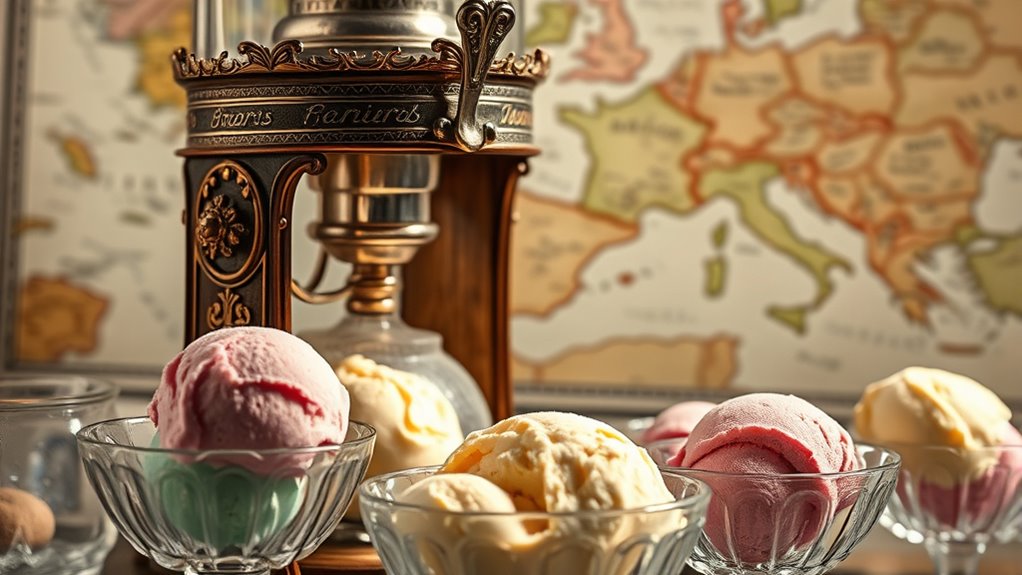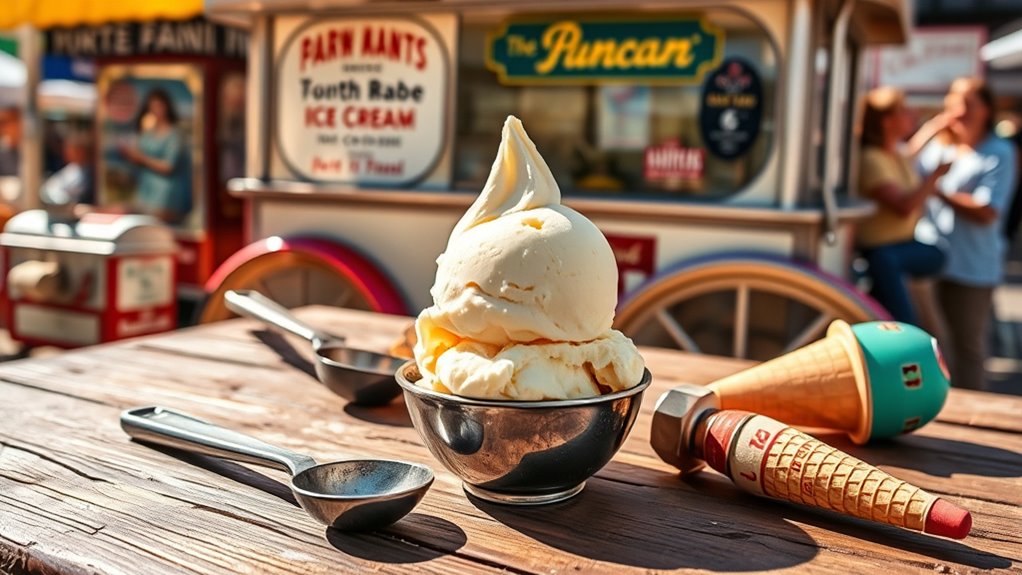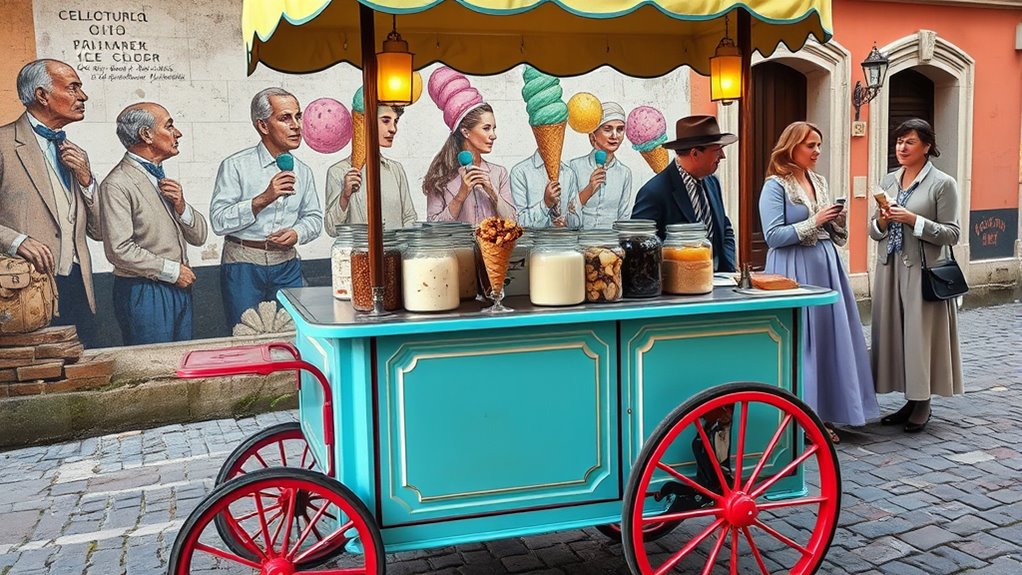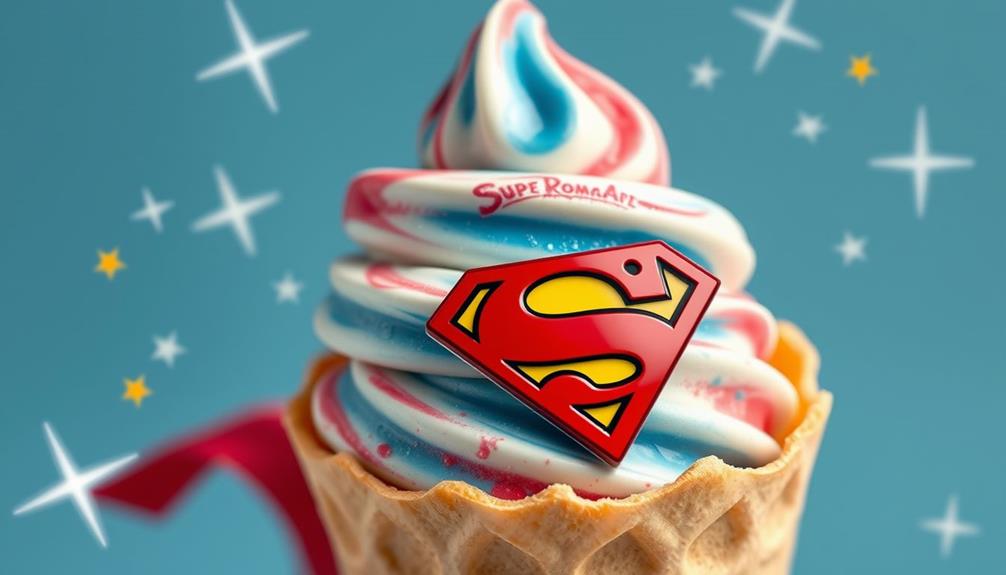Ice cream’s history dates back to ancient times, with icy treats enjoyed in Mesopotamia and flavored ices favored by Roman emperors. It evolved in 17th-century Europe as a symbol of wealth, served at royal courts. By the 19th century, industrialization made ice cream more accessible to everyone. Today, you can enjoy many global variations and flavors. There’s so much more to discover about how this beloved dessert came to be!
Key Takeaways
- Ice cream’s origins trace back to ancient civilizations, with icy treats enjoyed in Mesopotamia and flavored ices created by Greeks and Romans.
- By the 17th century, ice cream became a luxury in Europe, popularized by King Charles II and served at royal events.
- The first commercial production of ice cream began in 1851, thanks to Jacob Fussell, leading to increased availability and lower costs.
- Global variations of ice cream include Italian gelato, Indian kulfi, and Japanese kakigori, each reflecting unique cultural flavors and textures.
- Technological advancements and changing consumer preferences have led to diverse offerings, including dairy-free and vegan ice cream options in contemporary markets.
Early Frozen Desserts

Although ice cream as it’s understood today is a product of modern innovation, early frozen desserts have a rich history that dates back thousands of years.
In Mesopotamia around 4000 B.C., nobles created ice houses to enjoy icy treats during hot summers. Ancient Persia also contributed with a rejuvenating dessert called faloodeh, made from ice and syrup, showcasing early freezing techniques.
The Greeks mixed snow with honey and fruits, while Roman Emperor Nero delighted in flavored ices crafted from snow and fruit.
The Greeks and Romans savored frozen delights, blending snow with honey, fruits, and flavors long before modern ice cream.
Even in China during the Tang dynasty, a concoction of milk and rice combined with snow created a sweet treat, hinting at the global appreciation for frozen delicacies long before the rise of ice cream in royal courts.
The Birth of Ice Cream in Europe

You might be surprised to learn that ice cream first took shape in Italy during the early 1600s, where recipes for water ices began to emerge.
By the mid-17th century, it became a luxurious treat served at royal banquets across Europe, with King Charles II enjoying it in England.
As innovations continued, ice cream evolved into the creamy delight we recognize today, thanks to royal patronage and advancements in freezing techniques.
Early European Innovations
As ice cream began to emerge in Europe during the early 1600s, Italy became the birthplace of this beloved dessert, with early references appearing in the 1620s.
The mid-17th century saw early European innovations flourish, particularly in France and Italy, where ice cream transformed into a luxurious treat served at grand banquets.
King Charles II famously introduced ice cream to his table in 1672, solidifying its royal status.
In 1694, Antonio Latini published the first known recipe for a milk sorbet, further enhancing the art of frozen desserts.
The introduction of freezing techniques, such as mixing ice with salt, allowed chefs to create scoop-able frozen treats that delighted the palate and laid the foundation for modern ice cream as it’s understood.
Royal Patronage and Exclusivity
Ice cream quickly became a symbol of wealth and privilege in 17th-century Europe, enchanting the elite with its luxurious allure.
You’d find King Charles II serving this exclusive delicacy at his court, making it a favored treat among royalty. The first known reference to ice cream in England appeared during the Feast of St. George banquet at Windsor Castle in 1671, showcasing its status as a luxury item.
Only the upper classes enjoyed access to ice cream recipes, which remained closely guarded secrets. By the 18th century, wealthy individuals constructed ice houses, ensuring they’d ice to create this frozen delight during warmer months.
Its association with affluence solidified ice cream’s place in high society, mesmerizing those who craved indulgence.
Ice Cream in North America

When you think about ice cream in North America, you can trace its roots back to the 18th century with early references from notable figures like George Washington and Thomas Jefferson.
As production methods evolved, ice cream became a staple in American culture, especially with the rise of ice cream parlors in the late 19th century.
Today, it’s hard to imagine summer without this beloved treat that continues to bring people together.
Early American References
Although ice cream’s origins trace back to ancient cultures, its first notable appearance in North America occurred in a letter from 1744, penned by a guest of Maryland Governor William Bladen. This marked one of the earliest mentions of the dessert in the New World.
By the late 18th century, ice cream gained popularity among the elite. President George Washington was known to spend about $200 on it during the summer of 1790, and Thomas Jefferson served it at the executive mansion at least six times. The first advertisement for ice cream appeared in the New York Gazette on May 12, 1777.
| Year | Event |
|---|---|
| 1744 | Early mention by Governor Bladen |
| 1777 | First advertisement in New York |
| 1790 | George Washington’s ice cream spending |
| 1800s | Ice cream as a rare dessert |
Industrialization of Production
As the demand for ice cream surged in the mid-19th century, Jacob Fussell revolutionized its production by introducing large-scale manufacturing in 1851.
This industrialization considerably increased ice cream production and lowered costs. Technological advancements, like steam power and mechanical refrigeration, transformed the industry, enabling mass distribution.
By the 1870s, insulated ice houses allowed manufacturers to store ice longer, leading to year-round production instead of seasonal availability.
The early 20th century saw the introduction of motorized delivery vehicles, further enhancing accessibility to ice cream for the general public.
Today, the total frozen dairy production in the U.S. exceeds 6.4 billion pounds annually, showcasing the impressive scale of the ice cream industry and its evolution into a staple treat.
Popularity in Modern Culture
Ice cream isn’t just a treat; it’s a cultural phenomenon in North America. The popularity of this delightful dessert can be traced back to its first advertisement in the New York Gazette in 1777, paving the way for its growth. President Thomas Jefferson was an early enthusiast, showcasing ice cream’s luxurious status. During World War II, ice cream served as a morale booster, with military branches vying to provide it to troops. The post-war era saw consumption skyrocket, with Americans enjoying over 20 quarts per person in 1946. Today, ice cream sodas and unique flavors continue to thrive in modern culture.
| Year | Event |
|---|---|
| 1777 | First advertisement in New York |
| 1790 | George Washington spends $200 on ice cream |
| WWII | Ice cream boosts troop morale |
| 1946 | Americans consume 20+ quarts each |
| Modern Day | Popularity remains strong |
The Industrialization of Ice Cream

The industrialization of ice cream transformed it from a luxury treat into a staple enjoyed by many.
Beginning in the early 19th century, innovations like insulated ice houses allowed for increased production capabilities. In 1851, Jacob Fussell pioneered ice cream manufacturing in the United States, leading to mass production that made ice cream accessible to all.
Technological advancements, including steam power and mechanical refrigeration, greatly boosted production efficiency and capacity.
By the late 19th century, motorized delivery vehicles revolutionized how ice cream reached consumers, expanding its availability.
Innovations in Ice Cream Production

While many enjoy ice cream today, its production has evolved considerably over the years due to key innovations.
The invention of the ice cream machine in 1843 revolutionized the process, making it easier to create smoother ice cream without hand stirring.
Jacob Fussell’s large-scale manufacturing in 1851 marked the start of industrial ice cream production, while advancements in mechanical refrigeration in the late 19th century minimized the need for ice, enhancing storage and transport.
In the 20th century, the introduction of soft-serve ice cream, with its increased air incorporation, led to the popularity of chains like Dairy Queen.
The emergence of ice cream soda in the 1870s also transformed consumption patterns, giving rise to the iconic American soda fountain.
Global Variations of Ice Cream

Although ice cream is a beloved treat worldwide, each culture has put its unique spin on this classic dessert, creating a delightful array of variations.
Here are three popular global interpretations you might enjoy:
- Italian Gelato: Known for its dense texture and lower fat content, gelato uses more milk and less cream, delivering a creamier mouthfeel.
- Kulfi: This Indian delight is made from condensed milk and flavored with cardamom, saffron, or pistachios, often served on a stick.
- Kakigori: In Japan, this shaved ice dessert is topped with flavored syrups, providing a rejuvenating treat during hot summers.
With the rise of dairy-free ice creams made from almond or coconut milk, vegan options are now widely available, catering to diverse preferences.
Ice Cream Culture and Consumption Trends

As ice cream continues to evolve, its cultural significance and consumption trends reflect broader societal changes. Post-World War II, you saw ice cream’s popularity soar, with Americans consuming over 20 quarts per person in 1946.
By 2015, the U.S. produced nearly 900 million gallons, showcasing its status as a beloved dessert. Today, specialty ice cream stores and unique restaurants draw you in with nostalgic charm and innovative flavors. Alongside traditional options, frozen yogurt and dairy-free, vegan alternatives like those made from soy or coconut milk cater to health-conscious consumers. Additionally, the rise of lower-calorie versions of ice cream reflects growing awareness of health considerations among consumers. Ice cream vendors often set up at public events, using music and vibrant carts to create a festive atmosphere, emphasizing ice cream as a social treat that brings people together.
The Science of Ice Cream

Ice cream’s delightful texture and flavor stem from a fascinating blend of science and culinary artistry. Understanding the science behind ice cream can enhance your appreciation for this treat. Here are three key factors:
- Emulsification: Milk proteins help stabilize the mixture, allowing milk fat and water to blend smoothly.
- Air Incorporation: During freezing, air gets whipped into the mixture, creating a creamy texture and preventing large ice crystals.
- Freezing Point: At around -18°C, the movement of water slows, forming smaller ice crystals, which results in a smoother mouthfeel.
Despite its creamy deliciousness, don’t forget about its caloric content, which can reach up to 150 calories per half-cup, even in lower-fat varieties!
Frequently Asked Questions
Who First Invented Ice Cream?
You might think ice cream has a single inventor, but it’s more of a collective creation.
Different cultures contributed to its development over centuries. Ancient China, Persia, and Italy all played key roles in shaping what we now enjoy.
What Is the Surprising History of Ice Cream?
You might be surprised to learn that ice cream’s roots stretch back to ancient civilizations, where people enjoyed flavored ice and snow.
Fast forward to the 18th century, and influential figures like George Washington and Thomas Jefferson were indulging in this creamy delight.
Innovations in the 19th century, like the ice cream machine, made it more accessible.
Plus, the ice cream cone gained fame at the 1904 St. Louis World’s Fair, adding to its rich legacy.
Did Thomas Jefferson Invent Ice Cream?
No, Thomas Jefferson didn’t invent ice cream. He’s often credited with popularizing it in America after tasting it in France.
Jefferson embraced the dessert and even documented his recipe, which included cream and vanilla, in his cookbook. He used a manual ice cream maker he imported, showcasing his love for culinary arts.
What Is the Oldest Ice Cream in the World?
Did you know that ancient China’s ice cream-like dessert dates back to around 200 B.C.?
The oldest known version involved mixing milk, rice, and snow, offering a unique treat long before modern ice cream.
This early creation highlights how humans have enjoyed frozen delicacies for centuries.
While today’s ice cream has evolved, that ancient mix set the foundation for countless frozen desserts you savor today.
Conclusion
You might think ice cream is just a simple treat, but its rich history reveals a world of creativity and innovation. From ancient frozen desserts to today’s artisanal flavors, ice cream has evolved dramatically. It’s not just about sweetness; it reflects cultural shifts and technological advancements. So, the next time you indulge in your favorite scoop, remember you’re enjoying a delicious piece of history that connects us all, bridging generations and cultures with every bite.










